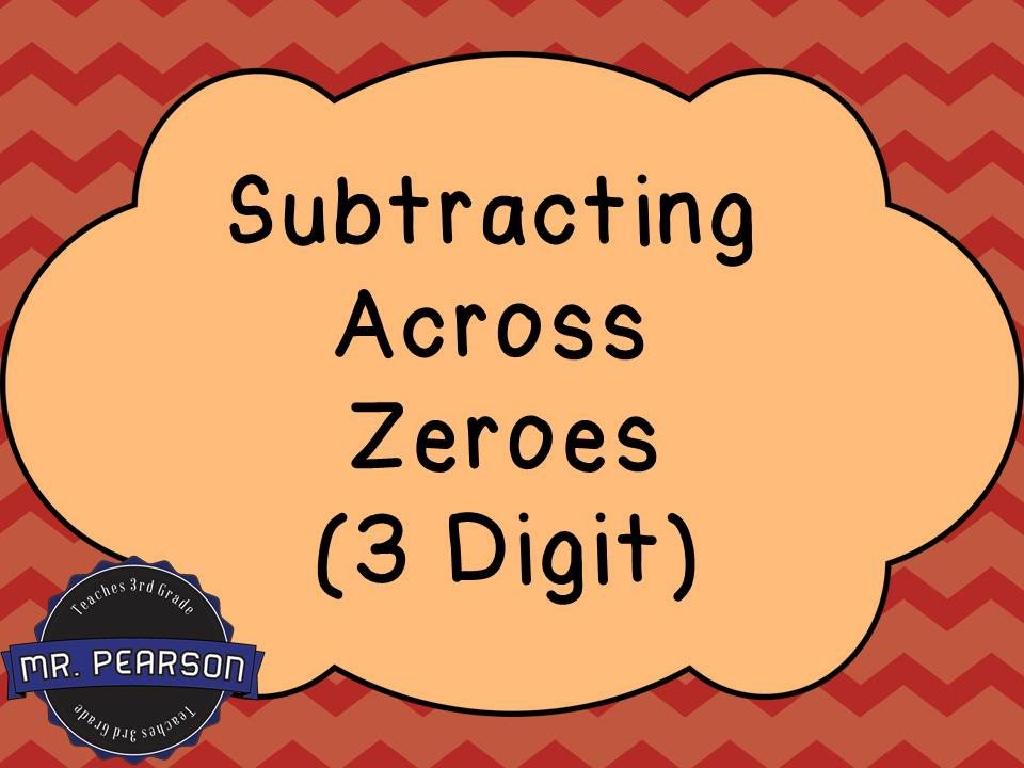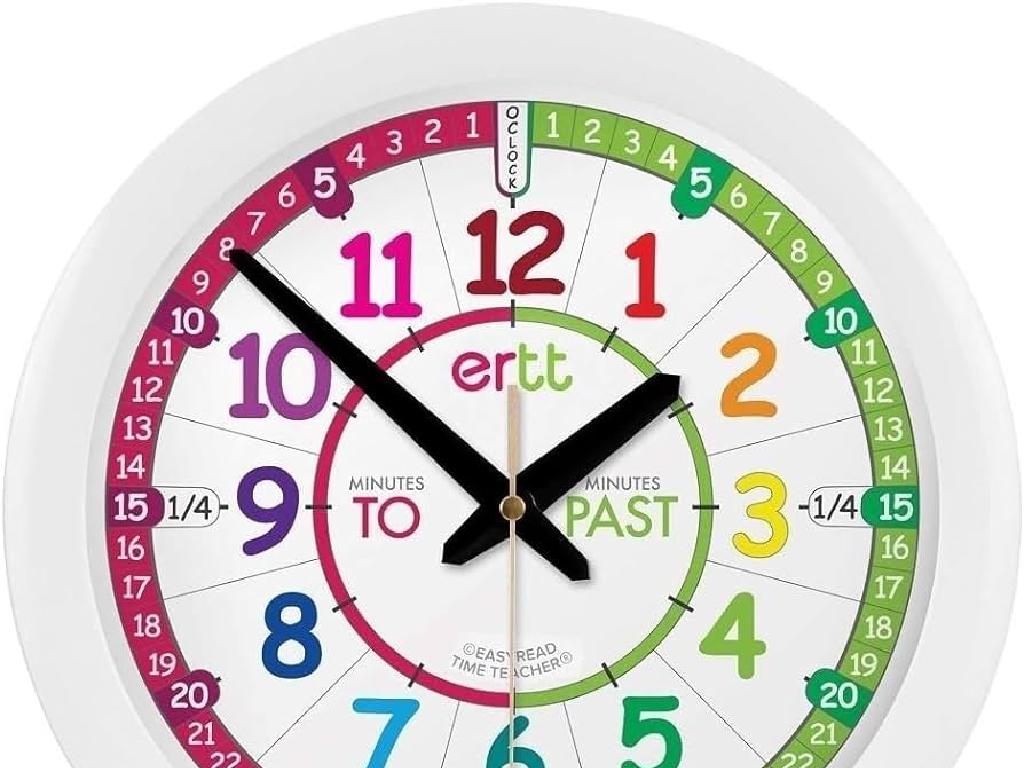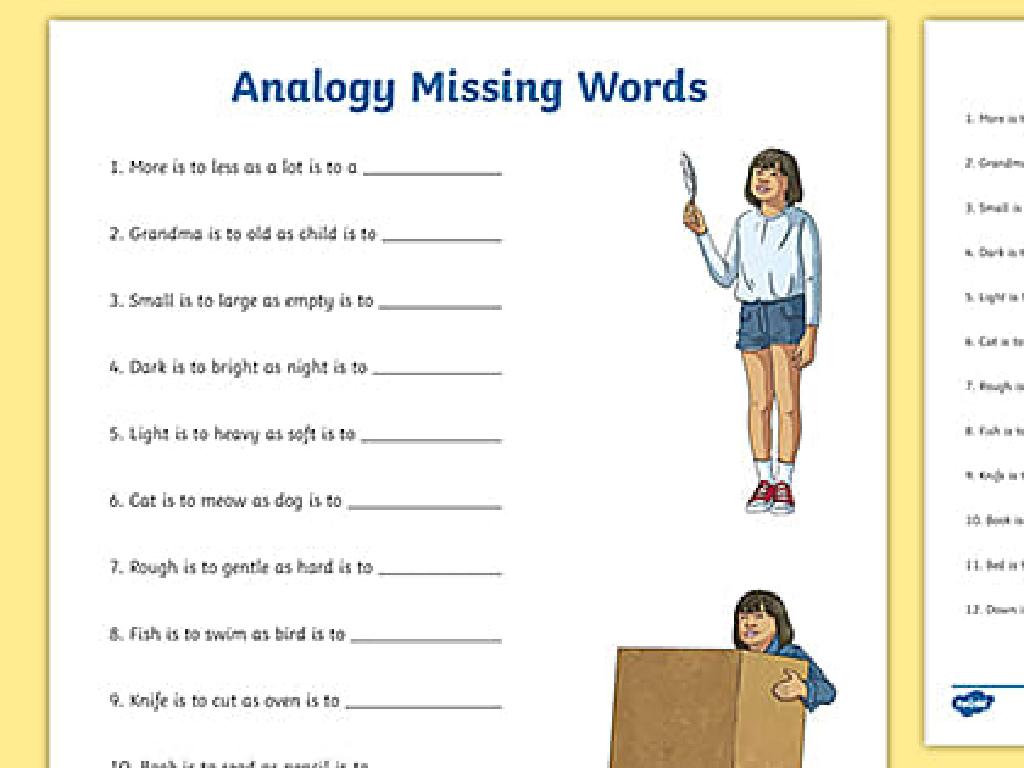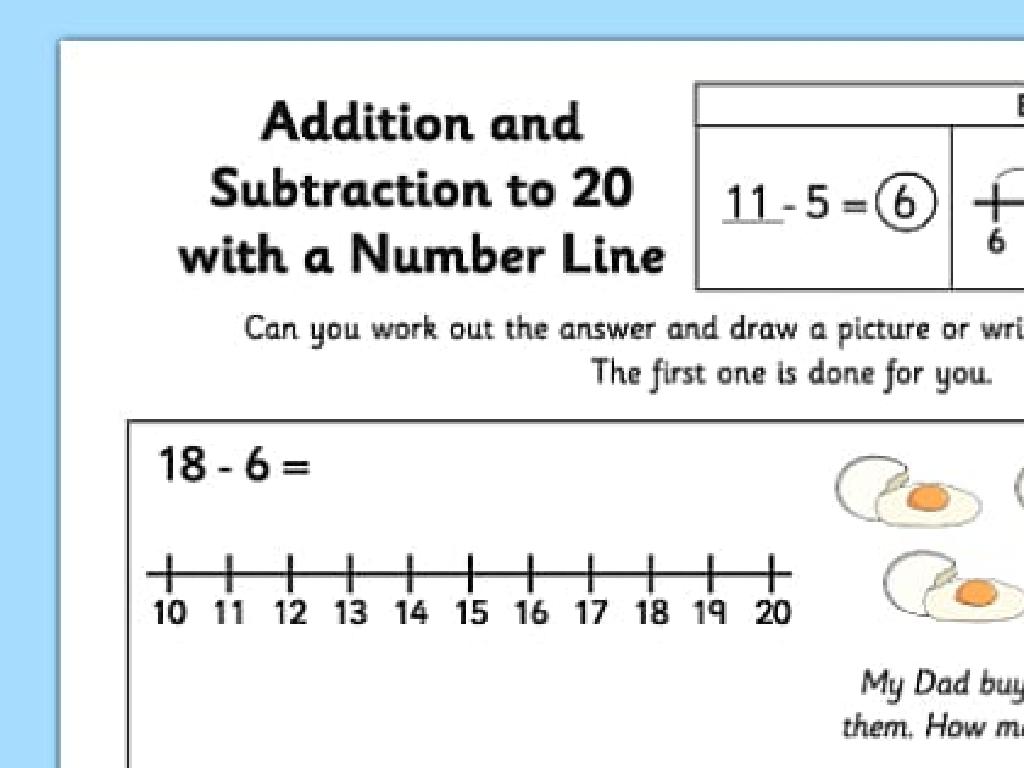Complete A Pattern
Subject: Math
Grade: First grade
Topic: Patterns
Please LOG IN to download the presentation. Access is available to registered users only.
View More Content
Welcome to Patterns!
– Greet the class with enthusiasm
– Today’s lesson: Learning about patterns
– Ask the class: What is a pattern?
– A pattern is a repeating design or rule.
– Explain patterns with simple examples
– Like red, blue, red, blue or circle, square, circle, square.
|
Begin the class with a warm and energetic greeting to capture the students’ attention. Introduce the concept of patterns, which are fundamental in math and everyday life. Engage the students by asking them to define a pattern, allowing them to think and respond. After listening to their answers, provide a clear and concise definition of a pattern, and use tangible and visual examples that are relatable to first graders, such as alternating colors or shapes. This will help them grasp the concept of patterns and prepare them for identifying and creating patterns on their own.
Understanding Patterns
– What is a pattern?
– A sequence that repeats logically
– Patterns are all around us
– In music, nature, and daily routines
– Examples of patterns
– Stripes on a zebra, days of the week
– Recognizing patterns
|
This slide introduces the concept of patterns to first-grade students. Begin by explaining that a pattern is a way that something is repeated in a logical or organized sequence. Highlight that patterns are not just a math concept but are present in various aspects of life, such as music (rhythms), nature (leaves or animal stripes), and even in our daily activities (routine schedules). Show visual examples of patterns, such as pictures of zebras, to help students recognize and understand patterns in a tangible way. Encourage the students to think of and share other examples of patterns they encounter in their lives.
Identifying Patterns
– Patterns use colors, shapes, numbers
– Like red, green, red, green or 1, 2, 1, 2
– Patterns follow a repeating rule
– A rule might be ‘color, color, shape, shape’
– Describe patterns with words
– For example, ‘star, heart, star, heart’
– Practice making your own pattern
|
This slide introduces the concept of patterns to first graders. Patterns are all around us and can be made using different elements such as colors, shapes, numbers, or objects. It’s important to convey that patterns follow specific rules that allow them to repeat in a predictable way. Encourage students to observe patterns in their environment and describe them using words. For instance, a pattern of colors could be ‘red, blue, red, blue’ and a pattern of shapes could be ‘circle, square, circle, square’. To reinforce learning, have students practice by creating their own patterns with classroom materials and describe the rule their pattern follows. This activity will help solidify their understanding of patterns and how to identify them.
Creating Our Own Patterns
– It’s your turn to make patterns
– Use blocks, stickers, or fingers
– Choose any objects you like for your pattern
– Patterns must repeat
– A pattern could be red, blue, red, blue or 1, 2, 1, 2
– Show your pattern to the class
|
This slide is designed to encourage students to apply their understanding of patterns by creating their own. Provide a variety of materials like blocks, stickers, or even have them use their fingers to create a repeating sequence. Remind them that a pattern is a design that repeats. For example, if using colors, they could alternate red and blue; if using numbers, they could alternate 1 and 2. Encourage creativity and ensure they understand that the pattern must be able to continue. After they create their patterns, have them present to the class to demonstrate their understanding and to practice their presentation skills. Prepare to offer guidance and praise their efforts to foster a positive learning environment.
Completing Patterns: Let’s Finish the Pattern!
– Patterns can be unfinished
– Use what we know to finish them
– Think about what comes next in line
– Let’s complete patterns together
– We’ll look at examples as a class
– Practice makes perfect
|
This slide introduces the concept of completing patterns to first graders. Begin by explaining that sometimes patterns are like puzzles that we need to solve. Encourage the students to observe and think about what should come next based on the pattern’s rule. During the class, work through examples together, allowing the students to suggest what the next item in the pattern should be. Provide a variety of patterns (shapes, colors, numbers) for them to complete. As an activity, have different patterns for students to complete, ensuring they understand that patterns follow a sequence. The goal is to build their confidence in recognizing and completing patterns through practice.
Pattern Practice: What Comes Next?
– Observe the patterns on the board
– Determine the next item in each pattern
– Look for a repeating sequence or rule
– Raise your hand to share your answer
– We’ll discuss why your answer fits
– We’ll explore the reasoning together
|
This slide is designed for an interactive class activity focused on recognizing and completing patterns. Begin by displaying various patterns on the board, which could include shapes, colors, numbers, or objects. Encourage the students to carefully observe the patterns and try to identify the rule that governs the sequence. Once they think they know what comes next, they should raise their hand to share their answer with the class. After a student responds, engage the class in a discussion about why the answer is correct, reinforcing the concept of patterns and the importance of understanding the rule that creates them. This activity will help students develop critical thinking and pattern recognition skills. Prepare several examples with varying difficulty and ensure to praise effort and participation.
Class Activity: Creating a Pattern Chain
– We’re making a paper chain
– Each student gets colored strips
– Choose a pattern for your chain
– Could be ABAB, ABBABB, or ABCABC
– Link the strips to form the chain
|
This activity is designed to help first graders recognize and create patterns, a fundamental math skill. Provide each student with strips of colored paper. Instruct them to choose a simple pattern to follow, such as alternating colors (ABAB), repeating pairs (ABBABB), or a sequence of three colors (ABCABC). Demonstrate how to create links by forming a circle with one strip and stapling or taping it, then threading the next strip through to create an interlocking chain. Encourage creativity and assist students who may have difficulty. Possible variations for different students could include using different shapes, adding stickers for a pattern, or varying the pattern complexity based on the student’s comfort level.
Review and Share: Pattern Wonders
– Review our created patterns
– Explain your pattern to classmates
– Describe the sequence and what repeats
– Celebrate our pattern learning
– Encouragement for great work
– A cheer for our pattern skills!
|
This slide is meant to conclude the lesson on patterns. Start by having students look at the patterns they’ve created during the class. Encourage them to come up to the front and explain the sequence and repetition in their patterns to their classmates. This will help reinforce their understanding and allow them to practice their communication skills. After each presentation, lead the class in applauding their efforts to foster a supportive learning environment. End the lesson by congratulating everyone on their hard work and understanding of patterns, emphasizing how important patterns are in math and in the world around us. Prepare to offer guidance and positive reinforcement throughout this activity.
Great Job on Patterns!
– Excellent work with patterns
– Patterns exist everywhere
– Nature, music, art, and daily routines
– Keep searching for patterns
– The more you look, the more you’ll find
– Practice makes perfect
|
This slide is meant to congratulate the students on their hard work during the lesson on patterns and to encourage them to continue observing patterns in their environment. Emphasize that patterns are not just a math concept but a part of the world around us, including nature, music, art, and even our daily routines. Encourage them to keep an eye out for patterns as this will help them get better at recognizing and completing them. This reinforcement will help solidify their understanding of patterns and their ability to predict what comes next in a sequence.






